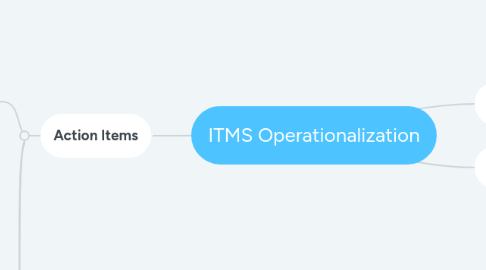
1. Process
1.1. Handhold Operators & Offers for Using ITMS
1.2. Feedback meetings with Operators and Officers
1.3. Internal Brainstorming for Operationalization
1.4. Define SOPs
1.5. Set Action Plans
1.6. Review RFP Contractual Requirements - Sumeet
2. Action Items
2.1. Within ITMS
2.1.1. Recurring Congestion Event - IBISC-7910
2.1.2. Alternative Routes Travel Time on VMB
2.1.3. Analytical Dasboard with ANPR Data
2.1.4. Patrol Vehicle Service Activation - TSCOP
2.1.5. Dynamic Reporting tool Integration with ITMS for Reporting Requirements
2.1.6. Violations Analytics Payments data to be revised as per payment date
2.1.7. Testing in Tabs for ITMS application
2.1.8. SOPs
2.1.8.1. UnPlanned
2.1.8.2. Planned
2.1.8.3. Provide help note on where and when to use TBI by whom
2.1.8.4. Hotlist
2.1.8.5. Special Events
2.1.9. Publishing some Key KPIs on VMB
2.1.10. Allow additional new numbers to added in response plan to list for events
2.1.11. Mobile VMB - Seperate Response Plan Templates to be created
2.1.12. Update Mobile VMB Locations based on AVL
2.2. External
2.2.1. Travel time data from external - Google /TomTom
2.2.2. Accident Data Gaps Fixing - CCTNS Service
2.2.3. Hotlist Vehicle List cleanup to inlcude only important categories to have focus
2.2.4. CCTV Integration with ITMS
2.2.5. Violation Payment Data Service & Revision of Dashboards Accordingly
2.2.6. Access of ITMS System to Senior Officers for Dashboards
2.2.7. Access of ITMS to Feild Operators - Tabs
2.2.8. CCTV Integration within ITMS - LnT
2.2.9. Mobile Units for Response Plan Dissemination - Department
2.2.10. Traffic Signal Integration for Timing Optimization and Route Prioritization- BEL
2.2.11. Twitter Key - Department
2.3. External - Longterm
2.3.1. VMB Connectivity
2.3.2. Dial 100 for Input to Safe&smart city
2.3.3. Pollution Data for Dashboard
2.4. O&M Report Templates
2.4.1. Daily, Monthly & Quarterly O&M Reports
3. Pain points
3.1. Expressed by Department
3.1.1. Input Data - for Congestion to create events is not available
3.1.2. We can not access system outside control center
3.1.3. Field Staff will not be able to communicate back to Control Center for coordination while handling incidents
3.1.4. VMB Connectivity is very low to cover many roads
3.1.5. Having too many alerts is diluting the focus for hotlist vehicles
3.1.6. Automated Call (similar to Dial 100) should also be part of response plan to get attention of responder
3.1.7. Not able to track Hit & Run Cases
3.1.8. CCTV Monitoring within ITMS
3.1.9. The font size in portable &fixed VMB is very small to read
3.1.10. CCTV coverage is not good enough to identify the source of congestion and confirm
3.1.11. I am not able to send SMS to any one he wants in response plan
3.2. Identified Internally
3.2.1. Facebook & Twitter are not active for real pages
3.2.2. Data Gaps with Service - Accidents - CCTNS
3.2.3. Recurring Congestion Alerts from ATCC can not help... it needs to be non - recurrant
3.2.4. Operators are issuing challans for the violations of 3% detected from ITMS
3.2.5. Hotlist response plan is not reaching patrol vehicles
3.2.6. Actual violations detected by ANPR systems are not being analyzed
